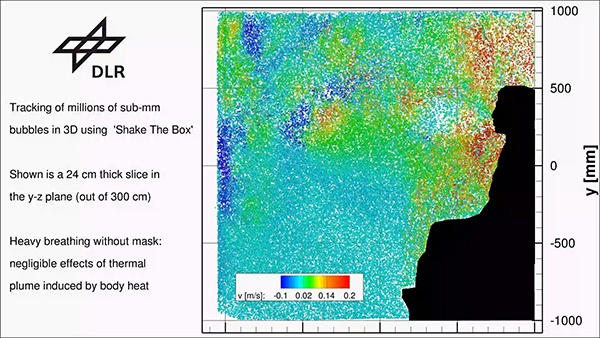Aeromask – Aerosols and their interaction with face masks
The DLR Institute for Software Technology, the Institute of Aerospace Medicine and the Institute of Aerodynamics and Flow Technology are investigating the effectiveness of oronasal masks in the joint project « Aeromask ». The experiments make quantitative statements about the influence of face masks on the behavior of exhaled aerosols and particles.
Project goal
In contrast to earlier pandemics, molecular biological detection methods are now available to track the spread of a pandemic and its source, in this case the SARS-Cov-2 virus. It is still unknown, however, how exactly the viruses excreted by humans are distributed. The « Aeromask » project investigates the spread of aerosols when using different nose-mouth masks. The aim is to clarify how aerosol particles and health damaging germs form an aerosol cloud around the infected person and spread in the room.
Test series under laboratory conditions
|
In a series of experiments under laboratory conditions, the influence of masks on the respiratory flow and thus on the propagation of aerosols in the environment is analyzed.With the help of state-of-the-art wind tunnel measurement technology from aerospace research, aerosol particles in exhaled air are tracked in different scenarios as they pass through oronasal masks. Techniques of numerical flow simulation and visualization are used to calculate and graphically display their subsequent dispersion. The results are precise estimates of the fate and distribution of aerosol particles in the ambient air.
Masks
The project focuses less on the filtering effect of masks than on their influence on the flow carrying the aerosols. Since masks may only marginally restrict breathing pressure, a great similarity in aerodynamic behavior between different mask types can be expected. For this reason, the extent to which the electret (electrostatically charged intermediate layer) is still intact in certified FFP2 masks or whether a mask additionally contains an antibacterial and antiviral layer plays a subordinate role in flow investigations. The situation is different with visors or FFP3 masks with valves that divert the flow instead of slowing it down.
Main focus of the investigations
The laboratory tests as well as the flow simulations will take place from autumn 2020 to spring 2021. The following aspects are involved:
-
- Effect of disposable masks on the particle load in the environment.
-
- Handling of masks and effect on their protective function: Wearing method, changing intervals of soaked masks
-
- Dispersion behavior of aerosol particles after passing through masks, velocity distribution
-
- Simulation and visualization of the propagation of aerosol clouds in open and closed rooms in which individuals or groups of people are present.
-
- Effect of ventilation behaviour and air movement on excreted aerosols
-
- Long-term behaviour of aerosols and possible accumulations
-
- Random determination of the germ load of worn masks: determination of the exhaled (and possibly re-inhaled) germs for their hazard potential and risk assessments (secondary infection pathways)
Evaluation of the results
The first phase of the research project was completed in October 2020. Here, the fluid mechanics of respiratory and ambient air and the influence of different everyday masks were investigated. The results were published in the online corona dossier on DLR.de in German: Wie effektiv sind Alltagsmasken? – Wissenschaftlicher Blick auf eine viel diskutierte Frage
The first laboratory phase of the project is now followed by two further phases in order to deepen the statements about the infectivity and movement of the aerosols distributed in the room. In the next step, a simulation and visualization of the movement of aerosols and particles in space will be created at the DLR Institute for Software Technology based on the measurement data. The properties of simulated bioaerosols (defined mixtures of different microorganisms) and their interaction with masks are investigated by the DLR Institute of Aerospace Medicine in the Aerospace Microbiology group.
After evaluation of the results in spring 2021, statements will be available on the extent to which respiratory masks can reduce aerosol density or velocity and what influence the room geometry and local flow situation have on the range of the aerosols. The results of the project provide important impulses for politics and society: how, for example, must traffic and event concepts be adapted in order to reduce the risk of infection in the event of pandemics in the future?
Visualizations of the aerodynamics of exhaled air with and without oronasal mask
Millions of small helium-air-filled bubbles are tracked using DLR’s proprietary particle tracking method « Shake The Box ». In this way, the entire room air flow with the dynamics of the inhaled and exhaled air streams can be measured and visualized in a 3D reconstruction. The image shows a 14 cm thick section in the y-z-plane (from 300 cm). The mask slows down the exhaled air flow, which migrates to the ceiling of the room due to the thermals (body heat) and follows the flow field there. Without the mask, the airflow moves directly forward during exhalation.


Below visualizations of flow structures (with and without mask) caused by cyclic breathing and thermals by isocontour surfaces of the vortex strength (Q-criterion). Color coding with the vertical velocity component.


Project partners
-
- DLR Institute for Software Technology
-
- DLR Institute of Aerospace Medicine
-
- DLR Institute of Aerodynamics and Flow Technology
Project run-time
Source: DLR – Institute for Software Technology – Aeromask – Aerosols and their interaction with face masks

